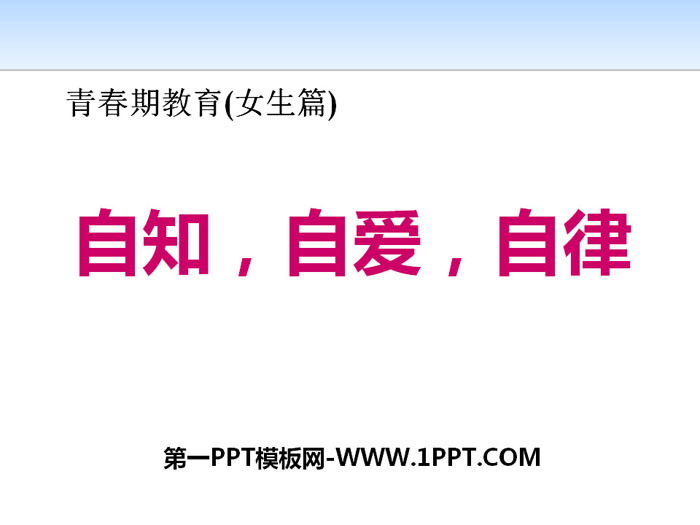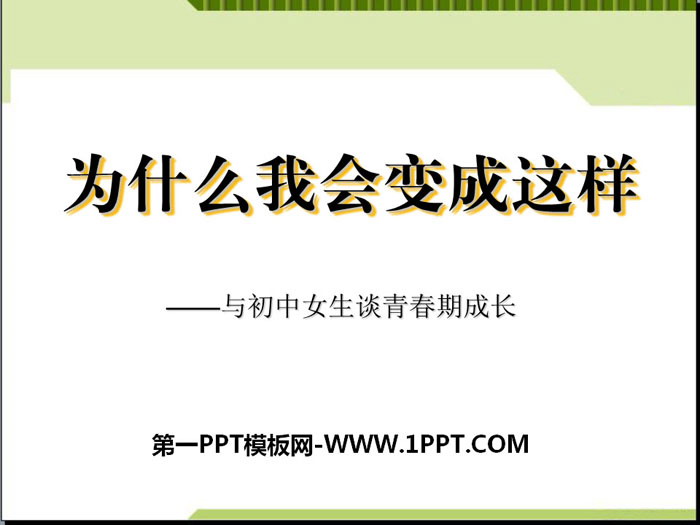
| Category | Format | Size |
|---|---|---|
| Health theme class meeting PPT | pptx | 6 MB |
Description
"Pay attention to hygiene and prevent diseases" PPT
Executive summary
1. What are the most common intestinal infectious diseases in autumn?
2. What are the main ways of spreading common intestinal infectious diseases?
3. What are the main symptoms of intestinal infectious diseases?
4. What should we pay attention to to prevent common intestinal infectious diseases in autumn?
5. What are the common respiratory infectious diseases in winter?
6. What are the main ways of spreading common respiratory infectious diseases?
7. What are the main symptoms of respiratory infectious diseases?
8. How to prevent respiratory infectious diseases?
1. What are the most common intestinal infectious diseases in autumn?
The most common intestinal infectious diseases in autumn include cholera, typhoid fever, dysentery, hepatitis A, hepatitis E, bacterial food poisoning, infectious diarrhea, etc. These diseases have an acute onset, spread quickly, are highly contagious, are highly harmful, and can easily cause explosive epidemics.
Cholera
(1) Diarrhea and vomiting stage: The main symptoms are painless severe diarrhea and watery rice stools, several to more than ten times a day, or even uncountable times, with the stool volume exceeding 1000m1 each time.
(2) Dehydration and collapse stage: Due to persistent and frequent diarrhea and vomiting, the patient rapidly develops water loss and circulatory failure. There may be irritability, panic expression, or indifference, dull expression, and hoarse voice. Thirst, dry lips, wrinkled skin, and sunken eyeballs. The whorls of the hands and feet are wrinkled, and breathing, pulse, heart sounds, and blood pressure will change. If the collapse period is too long, reactive fever may occur, and a few patients, especially children, may die due to high fever or excessive fever.
(3) Response (recovery) period: After the dehydration is corrected, the patient recovers quickly.
bacillary dysentery
Acute bacillary dysentery is divided into four types: mild, ordinary, severe and poisonous.
1. Ordinary type: (Typical) onset is sudden, high fever accompanied by chills, abdominal pain, diarrhea, pus, blood and mucus in stool, accompanied by tenesmus, 10 to 20 times per day.
2. Mild: (atypical) systemic toxemia and mild intestinal symptoms. Abdominal pain and diarrhea are mild, and the diarrhea does not exceed 10 times a day. There is mucus in the stool without pus and blood. It is easily misdiagnosed as enteritis and recovers in 3 to 6 days.
3. Poisoning type: more common in children, with sudden onset and dangerous illness. T40℃ or above, systemic toxemia symptoms.
4. Chronic bacillary dysentery: The course of acute bacillary dysentery lasts for more than 2 months without recovery.
①Chronic protracted type: long-term recurring abdominal pain and diarrhea. Or constipation and diarrhea appear alternately, there may be tenderness in the abdomen, and there may be pus and blood in the stool.
② Acute attack type: Chronic bacillary dysentery occurs suddenly due to eating cold food or catching cold.
③Chronic latent type: There is a history of acute bacillary dysentery within 1 year. The incubation period of bacillary dysentery ranges from several hours to 7 days, usually 1 to 3 days.
Hepatitis A
Hepatitis A is an important intestinal infectious disease caused by hepatitis A virus (HAV), mainly causing liver damage. At the beginning of the disease, the patient feels weak and anorexic, especially unwilling to eat greasy food. He often feels nausea, diarrhea, and pain in the upper right abdomen. Some patients also have fever, yellow eyeballs, and urine as yellow as strong tea. The main target of this disease is children. Most of the patients have mild symptoms and often have latent infection. In older patients, the disease is more severe and lasts longer.
2. What are the main ways of spreading common intestinal infectious diseases?
Intestinal infectious diseases are mainly transmitted orally through hands, water, food, etc. contaminated by germs. Pests such as flies and cockroaches can act as vectors for intestinal infectious diseases.
1. Transmitted by water
Cholera, typhoid and paratyphoid
2. Transmitted through food
Mostly outbreaks, salmonella enteritis, dysentery, etc.
3. Contact transmission
4. Transmitted by flies and other vector organisms
3. What are the main symptoms of intestinal infectious diseases?
★The main symptoms of the patient are acute diarrhea and vomiting. As long as they seek medical treatment in time, they can completely recover. If not treated in time, serious complications will occur, such as dehydration, toxemia, etc., and serious cases may cause death.
★Diarrhea refers to loose or watery stools three or more times a day.
4. What should we pay attention to to prevent common intestinal infectious diseases in summer and autumn?
(1) Develop good hygiene habits and wash hands before meals and after using the toilet;
(2) Do not eat raw food. Food must be cooked thoroughly before eating, especially shellfish and crustacean seafood;
(3) Cooked food should be eaten while it is hot, and overnight food must be heated thoroughly before eating;
(4) All cooking utensils and tableware should be washed clean and kept dry after use;
(5) Raw and cooked food should be stored separately, and sterilized and unsterilized tableware should be stored separately to prevent cross-contamination;
(6) In summer and autumn, when intestinal infectious diseases are prone to occur, it is not appropriate to hold weddings, funerals, celebrations and other group gatherings for dinner.
5. Common respiratory infectious diseases in winter
Influenza (influenza)
(1) Acute respiratory infectious diseases caused by influenza viruses are highly contagious, and their incidence rates rank first among infectious diseases.
(2) The incubation period is 1 to 3 days. The main symptoms are fever, headache, runny nose, sore throat, dry cough, body muscle and joint aches and discomfort, etc. The fever usually lasts for 3 to 4 days, and may also manifest as severe pneumonia or gastrointestinal symptoms. influenza. The main sources of infection are patients and latent infections, and the infectious period is one week.
(3) The main route of transmission is direct transmission through air droplets, but it can also be transmitted indirectly through items contaminated with the virus. The population is generally susceptible to influenza.
mumps
(1) Respiratory infectious diseases caused by the mumps virus, known in traditional Chinese medicine as mumps or mumps, are more common in winter and spring, but infection epidemics can occur throughout the year. Outbreaks often occur in nurseries, kindergartens, schools and among military recruits. Epidemics occur approximately every 2 years. Life-long immunity can be obtained after one infection, but some individuals with low antibody levels can also be infected again.
(2) The incubation period is 14-21 days, with an average of 18 days. Most patients with main symptoms have no prodromal symptoms after being infected. Some patients may have symptoms such as fatigue, chills, loss of appetite, low fever, headache, etc., and then one side of the parotid gland will appear. Swelling or simultaneous swelling of the parotid glands on both sides, reaching a peak within 2-3 days, one or both sides of the face becoming deformed due to swelling, local pain, allergy, obvious pain when opening mouth and chewing, swelling and pain aggravated by eating acidic food, often Can affect adjacent submandibular gland.
(3) The transmission route is through the air through droplets of saliva or respiratory secretions of patients and healthy carriers. Food utensils or toys contaminated by the saliva of patients and healthy carriers can also cause infection if they come into contact with the mouth of a susceptible person within a short period of time.
6. What are the main ways of spreading common respiratory infectious diseases?
It is mainly transmitted through the air, short-distance droplets or contact with respiratory secretions.
7. Main symptoms of respiratory infectious diseases
The main symptoms are fever, headache, runny nose, sore throat, dry cough, body muscle and joint pain and discomfort, etc.
8. How to prevent respiratory infectious diseases
1. Classrooms must be ventilated and maintained with air flow every day. Regularly opening doors and windows for natural ventilation can effectively reduce the number of microorganisms in indoor air, improve indoor air quality, and regulate the microclimate of the room. It is the simplest and most effective method of indoor air disinfection. It may be due to the drop in temperature recently. We have found that some classes are not very good at opening windows for ventilation. We hope that as long as the weather conditions permit, the classroom windows should be opened as much as possible during class. No matter what the weather is, all windows should be opened after class. doors and windows. It is recommended that each class assign a dedicated person to be responsible for opening windows for ventilation in the classroom. The best ventilation times are from 9 a.m. to 10 a.m. and from 3 p.m. to 4 p.m.
2. Get vaccinated. Common infectious diseases now generally have vaccines. Planned artificial automatic immunization is the main link to prevent the occurrence of various infectious diseases. Preventive vaccines are the best active means to prevent the occurrence of infectious diseases. If your family conditions permit, it is recommended that you go to the nearest vaccination unit to receive the relevant vaccines.
3. Developing good hygiene habits is the key to preventing infectious diseases in autumn. Keep your study and living places clean and do not pile up garbage. You must wash your hands according to prescribed procedures before meals, after using the toilet, and after returning from going out. Cover sneezing, coughing, and cleaning your nose with toilet paper. Do not leave used toilet paper lying around. Change, wash, and dry clothes and bedding frequently, and do not vomit anywhere. Do not mix phlegm and personal hygiene products.
4. Strengthen exercise and enhance immunity. You should actively participate in physical exercise and go to the countryside and outdoors to breathe fresh air. Daily exercise can make the body's energy and blood flow smoothly, stretch the muscles and bones, and strengthen the body. When exercising, you must pay attention to climate changes, avoid morning fog and wind and sand, arrange the amount of exercise reasonably, and self-monitor your physical condition to avoid adverse effects on the body.
5. Live a regular life. Get good sleep and rest. Living a regular life and getting adequate sleep are very important to improve your own resistance. It is necessary to arrange your work and rest reasonably, and your daily sleep time should not be less than 8 hours. Aim to live a regular life and balance work with rest. Overworking the body regardless of study or other activities will inevitably lead to a decrease in the ability to resist diseases and make one susceptible to viral infections.
6. Pay attention to the details of clothing and food. The climate in autumn is changeable and the temperature difference between morning and evening is large, which can easily reduce the body's respiratory immunity and make it easy for pathogens to invade. Students must add or remove clothes in a timely manner according to weather changes, and arrange their diet reasonably. The diet should not be too spicy, as too much will increase anger, and it should not be too greasy. To reduce irritation to the respiratory tract, do not smoke or drink alcohol, drink more water, take in enough vitamins, and eat more foods rich in high-quality protein, carbohydrates and trace elements, such as lean meat, eggs, and jujubes. , honey and fresh vegetables, fruits, etc.
7. Never hide a disease or avoid medical treatment. Since respiratory infectious diseases in autumn often have cold-like symptoms in the early stages, which are easy to be ignored, if you are not feeling well, tell your parents to take you to see a doctor as soon as possible. Especially if you have symptoms of fever and rash, you should make a clear diagnosis as early as possible and provide timely treatment. If there is an infectious disease, students should be isolated immediately and must not continue to attend class while sick. Take isolation measures to prevent the spread from spreading.
Keywords: Infectious disease prevention PPT courseware, infectious disease prevention theme class meeting PPT download, health theme class meeting PPT download, .PPT format;
For more information about the "Prevention of Infectious Diseases Theme Class Meeting" PPT courseware, please click the "Prevention of Infectious Diseases Theme Class Meeting" ppt tag.
"Common Infectious Disease Theme Class Meeting" PPT:
"Common Infectious Diseases Theme Class Meeting" PPT What are infectious diseases? Infectious diseases: diseases caused by pathogens that can be transmitted between people or between people and animals..
"Spring Infectious Disease Prevention" PPT:
"Prevention of Infectious Diseases in Spring" PPT Due to abnormal climate changes, spring is the season of high incidence of various respiratory infectious diseases. It is highly contagious and spreads quickly. Since our children's bodies are in the growth and development period, various systems are not fully developed and their resistance is low.
"Prevent Disease and Enjoy Life" PPT:
"Prevent Disease and Enjoy Life" PPT All things are recovering and spring is in full bloom. Spring is the most beautiful season of the year, but as the temperature rises, some viral infectious diseases also come. Therefore, in this beautiful season of spring, we must not forget to prevent some respiratory...
File Info
Update Time: 2024-07-04
This template belongs to Theme class meeting Health theme class meeting PPT industry PPT template
"Pay attention to hygiene and prevent diseases" PPT Simple campus recruitment activity planning plan summary enterprise and institution recruitment publicity lecture PPT template is a general PPT template for business post competition provided by the manuscript PPT, simple campus recruitment activity planning plan summary enterprise and institution recruitment promotion Lecture PPT template, you can edit and modify the text and pictures in the source file by downloading the source file. If you want more exquisite business PPT templates, you can come to grid resource. Doug resource PPT, massive PPT template slide material download, we only make high-quality PPT templates!
Tips: If you open the template and feel that it is not suitable for all your needs, you can search for related content "Pay attention to hygiene and prevent diseases" PPT is enough.
How to use the Windows system template
Directly decompress the file and use it with office or wps
How to use the Mac system template
Directly decompress the file and use it Office or wps can be used
Related reading
For more detailed PPT-related tutorials and font tutorials, you can view: Click to see
How to create a high-quality technological sense PPT? 4 ways to share the bottom of the box
Notice
Do not download in WeChat, Zhihu, QQ, built-in browsers, please use mobile browsers to download! If you are a mobile phone user, please download it on your computer!
1. The manuscript PPT is only for study and reference, please delete it 24 hours after downloading.
2. If the resource involves your legitimate rights and interests, delete it immediately.
3. Contact information: service@daogebangong.com
"Pay attention to hygiene and prevent diseases" PPT, due to usage restrictions, it is only for personal study and reference use. For commercial use, please go to the relevant official website for authorization.
(Personal non-commercial use refers to the use of this font to complete the display of personal works, including but not limited to the design of personal papers, resumes, etc.)
Preview



















